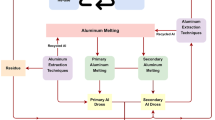Abstract
In this study, arsenic removal was carried out via low-temperature vacuum carbothermal reduction method by utilizing dust containing higher content of arsenic and copper from pyrometallurgical refining furnaces of copper as raw materials. Effect of various factors such as reduction temperature, residual pressure, reductant dosage and time on the removal rate of arsenic was investigated and explored in detail. Arsenic reduction kinetics was analyzed and elaborated in detail on the basis of “shrinking-core model”. The results show that arsenic removal rate is enhanced with low reduction temperature and increasing amount of reduction dose, and decreasing residual pressure. Arsenic reduction removal is indicated to be controlled by ash diffusion. Apparent activation energy ~15.96 kJ/mol is determined for the reaction in the temperature range of 623–773 K. The kinetic equations for arsenic removal during vacuum carbothermal reduction can be described as 1 – 2a/3 – (1 – a)2/3 = 0.05774 exp[–1919.05/T]t.










Similar content being viewed by others
REFERENCES
Yang, K., Liu, W., Zhang, T.F., Yao, L.W., and Qin, W.Q., Water leaching of arsenic trioxide from metallurgical dust with emphasis on its kinetics, J. Cent. South Univ., 2019, vol. 26, no. 9, pp. 2328–2339.
Xu, B., Ma, Y.P., Gao, W., Yang, J.K., Yang, Y.B., Li, Q., and Jiang, T., A review of the comprehensive recovery of valuable elements from copper smelting open-circuit dust and arsenic treatment, JOM, 2020, vol. 72, no. 5, pp. 3848–3860.
Wu, X.L., Luo, R.K., Li, T., Chen, H., Ge, S.Z., Zhong, S.P., and Wang, J.E., Removal of arsenic in copper smelting dust, Hydrometallurgy, 2019, vol. 38, no. 18, p. 488.
Huang, J.Q., Ma, Y.P., Xu, B., and Gao, W., Study on comprehensive recovery of copper smelting dust, Nonferrous Met., Extr. Metall., 2020, vol. 52, no. 3, pp. 17–22.
Zhou Hang, McConnell, J., Ring, T.A., and Sutherland, J.C., Characterization of temperature criteria using gas-phase fuel streams for MILD coal combustion, Fuel, 2021, vol. 296, no. 50, p. 120445.
Zhang, W.J., Che, J.Y., Wen, P.C., Xia, L., Ma, B.Z., Chen, J., and Wang, C.Y., Co-treatment of copper smelting flue dust and arsenic sulfide residue by a pyrometallurgical approach for simultaneous removal and recovery of arsenic, J. Hazard. Mater., 2021, vol. 416, no. 15, p. 126149.
Zhang, Z.T., Li, W.F., Zhan, J., Li, G., Zhao, Z.B., and Huang, J.Y., A novel technology for the recovery of zinc from the zinc leaching residue by the bottom-blown reduction, Miner. Process. Extr. Metall. Rev., 2021, vol. 42, no. 6, pp. 1–8.
Karimov, K.A., Naboichenko, S.S., Kritskii, A.V., Tret’yak, M.A., and Kovyazin, A.A., Oxidation sulfuric acid autoclave leaching of copper smelting production fine dust, Metallurgist, 2019, vol. 62, no. 10, pp. 1244–1249.
Yang, T.Z., Fu, X.X., Liu, W.F., Chen, L.L., and Zhang, D.C., Hydrometallurgical treatment of copper smelting dust by oxidation leaching and fractional precipitation technology, JOM, 2017, vol. 69, no. 10, pp. 1982–1986.
Gao, J.T., Huang, Z.L., Wang, Z.W., and Guo, Z.C., Recovery of crown zinc and metallic copper from copper smelter dust by evaporation, condensation and super-gravity separation, Sep. Purif. Technol., 2020, vol. 231, no. C, p. 115925.
Kovyazin, A., Timofeev, K.L., and Krauhin, S., Copper smelting fine dust autoclave leaching, Mater. Sci. Forum, 2019, vol. 946, no. 5, pp. 615–620.
Chen, Y., Wang, T., Marsh, M., and Williams, J.S., Mechanically activated carbothermic reduction of ilmenite, Metall. Mater. Trans. A, 1997, vol. 6, no. 28, pp. 1115–1121.
Qiu, K. and Zhang, R., Research on preparation of nanometer antimony trioxide from slag containing antimony by vacuum evaporation method, Vacuum, 2006, vol. 80, no. 9, pp. 1016–1020.
Guo, H.J., Metallurgical Physico-Chemistry Tutorial, 2004, pp. 281–320.
Tian, Y.W., Zhai, X.J., and Liu, K.R., Concise Course in Metallurgical Physical Chemistry, Beijing: Chemical Industry Press, 2011, pp. 223–325.
Rao, Y.K., The kinetics of reduction of hematite by carbon, Metall. Trans., 1971, vol. 2, no. 5, pp. 1439–1447.
Hussein, M.K., Kolta, G.A., and Saba, A.E., Kinetics of calcium phosphate reduction by carbon, Themochim. Acta, 1974, vol. 10, no. 2, pp. 177–186.
Luo, S.Y., Zhang, J.Y., and Zhou, S.P., Prediction System of Solid/Solid Reaction Kinetics, 2000, pp. 198–201.
ACKNOWLEDGMENTS
This study was supported by Graduate Research and Innovation Projects of Jiangsu Province (CN) (KYCX20_3133).
Author information
Authors and Affiliations
Corresponding author
Ethics declarations
The authors declare that they have no conflicts of interest.
About this article
Cite this article
Li, C., Zhang, R.L., Zeng, J. et al. Arsenic Reduction Kinetics during Vacuum Carbothermal Reduction of Dust with High Content of Arsenic and Copper. Russ. J. Non-ferrous Metals 63, 269–275 (2022). https://doi.org/10.3103/S1067821222030026
Received:
Revised:
Accepted:
Published:
Issue Date:
DOI: https://doi.org/10.3103/S1067821222030026




